How dinosaurs died out - the last heavy tanks (part 3)
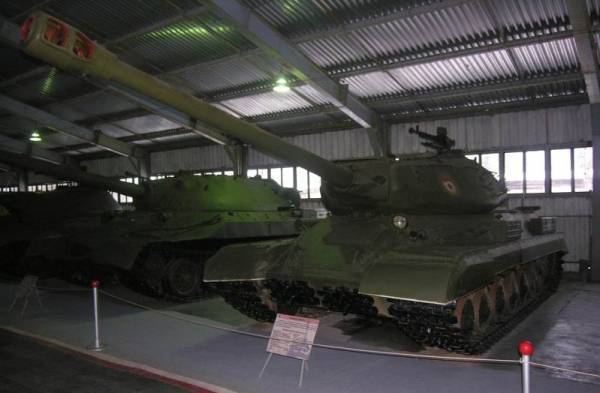
Heavy tank EC-4 - the last of the kind of "Stalin".
Long before the end of World War II, teams of several design bureaus were developing a promising heavy tank "for the final phase of the war and beyond." Among them was the design bureau of the Kirov plant, which began designing in December 1943. The main task was seen to be a sharp increase in the tank's security, in particular resistance to the new 88mm long-barreled anti-tank guns (the Red Army already managed to familiarize itself with the self-propelled version of Ferdinant during the Battle of Kursk). In addition to thickening the frontal armor plates, the entire nose structure was seriously redesigned compared to previous IS tanks, the increased mass of the tank required a more powerful engine, which led to a lengthening of the hull and the addition of a seventh road roller to the chassis. The hull was assembled by welding rolled armored plates, while the tower was completely cast, with the exception of part of the roof - a large plate held by bolts was a hatch for dismantling the gun. In April 1944, a GKO order issued an order to the ChKZ for the production of two prototypes of the “Object 701” (the new tank was so named in the factory documentation, which is interesting - the order was received earlier than the IS-3, which had the “703” index) . The first prototype, designated "701 No. 0" already in May of the same year entered the factory tests, which lasted a month and a half.
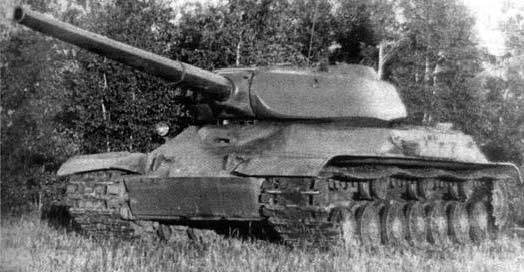
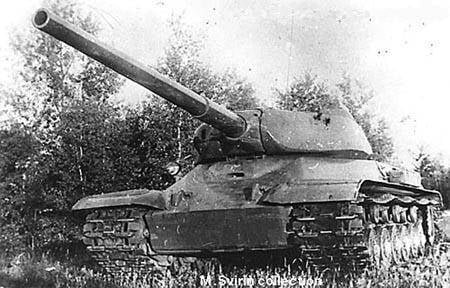
The result of the work to eliminate the identified deficiencies was the release of the following two prototypes - the 701 Object No. 1 and No. 3, which differed in weapons (it was supposed to use 100mm C-34 or 122mm D-25T tools). The tests of the modified samples, which lasted more than a month, followed, and the conclusion of the commission - the tank is certainly good, but it requires refinement. The plant was to produce the following two prototypes and re-submit them for testing. In August, 1944 received the first detailed information about the new German Tiger-B tank with a weapon similar to Ferdinant, and work on the new tanks was accelerated. Including conducted and experienced firing at the body of the "Object 701" with both domestic and trophy guns. The result was expected, and pleasantly pleased the testers - the corps reliably defended the tank during the shelling of the 88mm with long-barreled guns from course angles +/- 30 ° at all distances. The tower showed a slightly worse stamina - the safe angles were +/- 15 ° for it, but this is permissible, since the tower is more often deployed to the enemy and gets hit in the forehead at small steering angles. Prototype # 4 comes out for testing in September, but again the work of the nodes, and first of all, the transmission does not satisfy the commission, and two months later the “701 Object” #5 goes to state tests conducted at the Scientific Research Institute BT site in December-January. The tank is recommended for adoption, and passes two additional tests from January 1945 to March, and from March to April. The commission considers the tank to have passed the tests and confirms the initial decision to adopt. Moreover, the 701 Object No. 6 in Chelyabinsk was tested in April, and in its conclusions the commission noted that the reliability of the units is satisfactory, and their testing in serial production is sufficient to recommend adoption. In a letter to the People's Commissar of the tank industry V.Malyshev, the leadership of the Chelyabinsk Shipyard asked to approve the program of serial production of the tank from the summer of 1945, bringing the production rate to 100 machines per month by August! But ... At that time, it was already commissioned and launched into the 703 Object series under the name of EC-3, and there was simply no money left for two heavy tanks.
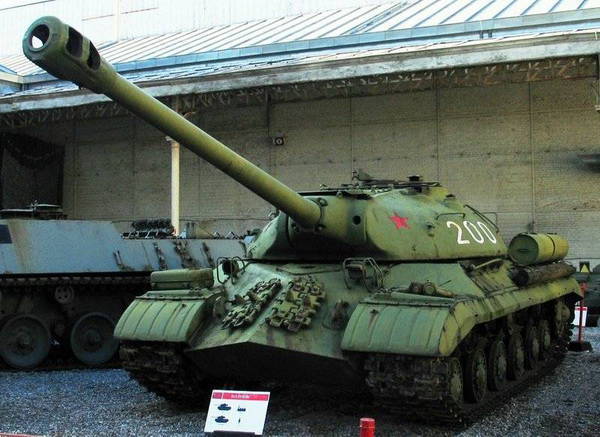
In this story “Seven hundred and first” would have ended, especially since the war was won, and the center of gravity of interests shifted towards the restoration of the national economy, however the unexpected happened - at the beginning of 1946, the tank EC-3, which caused a furore at the Victory parade, was removed from production. The shortcomings and unsuccessful shape of the nose part revealed during operation undermined the trust of the military to the car, the UCN program (eliminating design flaws) cost almost as much as the tank itself, and went to the repair shops of the EC-3 directly from the factory workshops. The final point in the fate of the EC-3 put the test shelling of the hull of the tank, when 100mm projectile hit the weld passing in the middle and fastened the two upper frontal parts. The result was disastrous - the tank literally collapsed, bursting at all the seams. The weakened zone was known before, but no one could assume that getting into it would cause such serious consequences. And so, the country suddenly turns out to be without the production of heavy tanks! In the current situation, having considered all the options, the Council of Ministers of the USSR in April of the same year made a decision on adopting the “701 Object” with the assignment of an EC-4 index to it. The release was supposed to begin by the end of the year, but the documentation required for this was not ready. Additional over 80 changes are introduced into the design, and the first two production tanks, the EC-4, are received for ministerial testing only in April, 1947. The conclusion of the commission turns out to be categorical - the test tanks did not survive! Reliability did not meet the requirements of peacetime (it was already impossible to close our eyes to the resource of the main components of the power unit and transmission in dozens of hours, as was the case in 1942, because the tank would still die before it exhausted the resource), the complexity of management and maintenance required special training of drivers, not to mention such “trifles” as the inability to use the radio station on the go and high noise (in calm weather fans could be heard ... for 7-8 kilometers!). Modified tanks in the summer are tested again, but they get another list from the 121 point of deficiencies. The tank is seriously reworked, new solutions are being worked out on 25 machines of the installation batch, and October 8 1947. The final drawings for serial production of the EC-4 are approved.
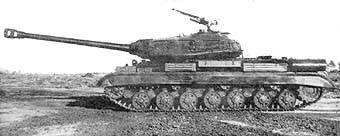
The release was sluggish, and despite the improvements, the tank did not meet the requirements of the army to the end. It got to the ban on accepting tanks from the 10 plant in January 1948 - followed by an "elevated tone" trial between the military and the Ministry of Transport Engineering, involving the Council of Ministers of the USSR (not the last in the fate of the tank, as it turned out), which resulted in two orders: continue acceptance and development of a program to eliminate the identified defects, with the modernization of all previously handed tanks. But already in August, a second conflict arose, exactly repeating the previous one, with similar conclusions. Acceptance resumes, only occurs captiously and methodically. The result of all altercations and mutual reproaches was the decision of January 1, 1949, to remove the tank from production. In total, the 219 of the EC-4 production tanks and six prototypes were produced. The tank service was painfully similar to the previously considered M103 and FV214 Conqueror - most of the vehicles were "exiled" to the Far East, where they were quickly decommissioned for long-term storage, and later decommissioned. The only complete copies that have survived to this day are the EC-4 from the exposition of the Museum of armored weapons and equipment (Kubinka near Moscow) and a monument in the village of Zabaikalye, Chita Region.
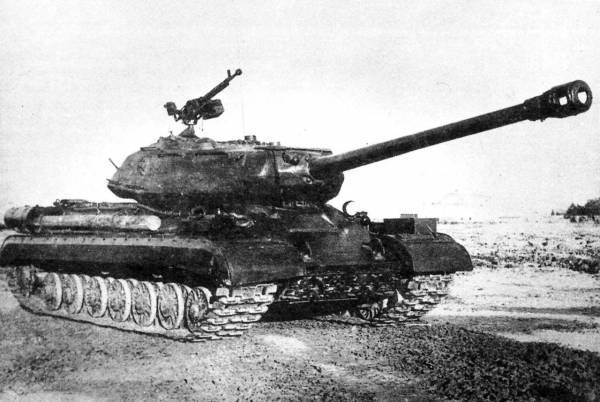
Tank EC-4 was designed according to the classic layout with rear-engine compartment. In the department of management there was a mechanic-driver, whose workplace was located along the axis of the tank. Access was through a round sliding hatch in which viewing devices were mounted (two periscopic MK-4, they had to be removed to open the hatch). The engine of the tank is a 12-cylinder, V-shaped diesel engine B-12, which is a further development of the B-2. Forcing to 750 hp made by introducing a centrifugal drive supercharger, in addition, many other changes have been made to the design. Of interest is the transmission of the tank, which consisted of a single gear mechanism and turns of the planetary type. The role of the gearbox was performed by a two-row planetary gear with three friction elements and a reverse, this provided the tank with six speeds forward and three back. The 3K type turning mechanism with multipliers was developed in 1935-36, but due to the complexity it was not mastered by industry at that time. On the one hand, it provided stable, rectilinear movement under any conditions, but during cornering the speed of the tank’s center of gravity significantly decreased and the engine was overloaded. Chassis included 7 supporting and 3 supporting roller, torsion bar suspension. The hull of the tank welded from katana armor, cast tower. The armament of the tank includes the X-NUMXmm threaded gun D-122T, with 25 ammunition, separate loading shots, and two large-caliber DShKM machine guns - coaxial and anti-aircraft. It is worth noting the method of storing shells in the tank - all 30 shells are located in the aft part of the tower in individual cassettes, which were designed for a specific type of projectile. Had 30 cassettes for armor-piercing shells and 12 for high-explosive fragmentation, for convenience, their pens were painted in red and yellow, respectively. Shells with charges were stored mainly in the case. Ammunition of machine guns consisted of 18 cartridges - 500 in five boxes (two are already mounted on machine guns) and 250 in factory packs. The gunner, as in the rest of the Soviet tanks, was located to the left of the gun, in front of the commander. At his disposal was a telescopic "breaking" sight TSH-250 and a periscope observation device. For the armor plate for dismantling the guns, there were hatches of the tank commander and loader, they were supplied with periscopic observation devices (the commander had TPK-45, the charging MK-1), the commander's turret was missing, as was the prismatic round-vision observation devices.
The advantage of the tank was a powerful armor that protects against the main anti-tank guns of the time, but it had no advantages over the EC-2 and EC-3. Low reliability, complexity in control and operation, insufficient mobility and maneuverability did not allow this most difficult of all Soviet production tanks to take a decent position in the army.
Brief performance characteristics of the heavy tank EC-4:
Crew - 4 person.
Weight in the fighting position - 60 tons.
Full length - 9,79 meters.
Width - 3,26 meter.
Height - 2,48 meter.
The maximum speed is 43 km / h.
Power reserve - 170km.
Ground pressure is 0,92 km / cm2.
Armament:
122mm threaded gun D-25T (30 shots separate charging).
Combined and anti-aircraft 12,7mm machine guns DShKM (general 500 ammunition ammunition).
Booking:
The forehead of the body is 160mm top, 140mm bottom.
The hull board - 160mm.
The forehead of the tower is 250mm.
The turret is 170mm.
Information